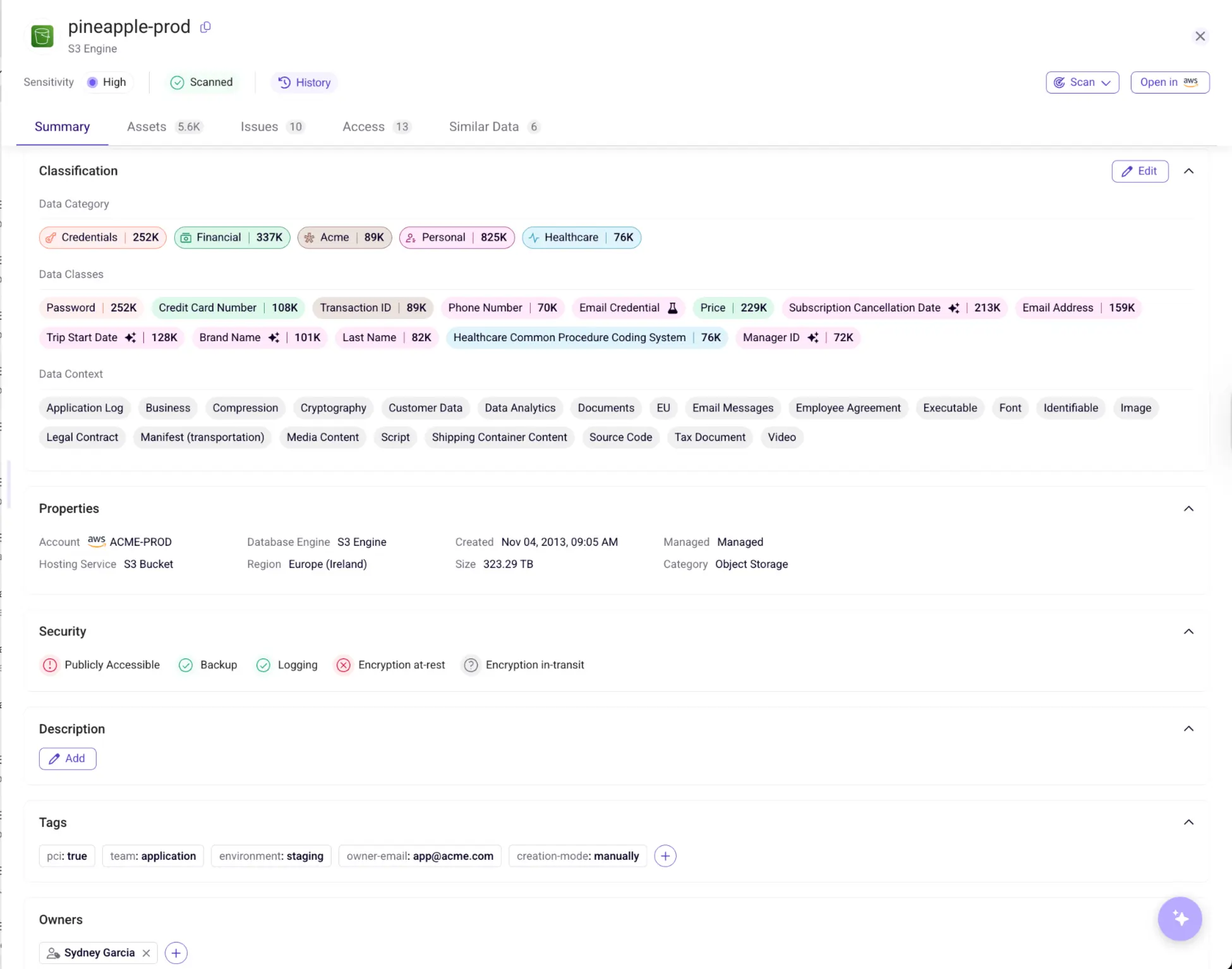PII Compliance Checklist: 2025 Requirements & Best Practices
What is PII Compliance?
In our contemporary digital landscape, where information flows seamlessly through the vast network of the internet, protecting sensitive data has become crucial. Personally Identifiable Information (PII), encompassing data that can be utilized to identify an individual, lies at the core of this concern. PII compliance stands as the vigilant guardian, the fortification that organizations adopt to ensure the secure handling and safeguarding of this invaluable asset.
In recent years, the frequency and sophistication of cyber threats have surged, making the need for robust protective measures more critical than ever. PII compliance is not merely a legal obligation; it is strategically essential for businesses seeking to instill trust, maintain integrity, and protect their customers and stakeholders from the perils of identity theft and data breaches.
Sensitive vs. Non-Sensitive PII Examples
Before delving into the intricacies of PII compliance, one must navigate the nuanced waters that distinguish sensitive from non-sensitive PII. The former comprises information of profound consequence – Social Security numbers, financial account details, and health records. Mishandling such data could have severe repercussions.
On the other hand, non-sensitive PII includes less critical information like names, addresses, and phone numbers. The ability to discern between these two categories is fundamental to tailoring protective measures effectively.
This table provides a clear visual distinction between sensitive and non-sensitive PII, illustrating the types of information that fall into each category.
The Need for Robust PII Compliance
The need for PII compliance is propelled by the escalating threats of data breaches and identity theft in the digital realm. Cybercriminals, armed with advanced techniques, continuously evolve their strategies, making it crucial for organizations to fortify their defenses. Implementing PII compliance, including robust Data Security Posture Management (DSPM), not only acts as a shield against potential risks but also serves as a foundation for building trust among customers, stakeholders, and regulatory bodies. DSPM reduces data breaches, providing a proactive approach to safeguarding sensitive information and bolstering the overall security posture of an organization.
PII Compliance Checklist
As we delve into the intricacies of safeguarding sensitive data through PII compliance, it becomes imperative to embrace a proactive and comprehensive approach. The PII Compliance Checklist serves as a navigational guide through the complex landscape of data protection, offering a meticulous roadmap for organizations to fortify their digital defenses.
From the initial steps of discovering, identifying, classifying, and categorizing PII to the formulation of a compliance-based PII policy and the implementation of cutting-edge data security measures - this checklist encapsulates the essence of responsible data stewardship. Each item on the checklist acts as a strategic layer, collectively forming an impenetrable shield against the evolving threats of data breaches and identity theft.
1. Discover, Identify, Classify, and Categorize PII
The cornerstone of PII compliance lies in a thorough understanding of your data landscape. Conducting a comprehensive audit becomes the backbone of this process. The journey begins with a meticulous effort to discover the exact locations where PII resides within your organization's data repositories.
Identifying the diverse types of information collected is equally important, as is the subsequent classification of data into sensitive and non-sensitive categories. Categorization, based on varying levels of confidentiality, forms the final layer, establishing a robust foundation for effective PII compliance.
2. Create a Compliance-Based PII Policy
In the intricate tapestry of data protection, the formulation of a compliance-based PII policy emerges as a linchpin. This policy serves as the guiding document, articulating the purpose behind the collection of PII, establishing the legal basis for processing, and delineating the measures implemented to safeguard this information.
The clarity and precision of this policy are paramount, ensuring that every employee is not only aware of its existence but also adheres to its principles. It becomes the ethical compass that steers the organization through the complexities of data governance.
The Java code snippet represents a simplified PII policy class. It includes fields for the purpose of collecting PII, legal basis, and protection measures. The enforcePolicy method could be used to validate data against the policy.
3. Implement Data Security With the Right Tools
Arming your organization with cutting-edge data security tools and technologies is the next critical stride in the journey of PII compliance. Encryption, access controls, and secure transmission protocols form the arsenal against potential threats, safeguarding various types of sensitive data.
The emphasis lies not only on adopting these measures but also on the proactive and regular updating and patching of software to address vulnerabilities, ensuring a dynamic defense against evolving cyber threats.
The JavaScript code snippet provides examples of implementing data security measures, including data encryption, access controls, and secure transmission.
4. Practice IAM
Identity and Access Management (IAM) emerges as the sentinel standing guard over sensitive data. The implementation of IAM practices should be designed not only to restrict unauthorized access but also to regularly review and update user access privileges. The alignment of these privileges with job roles and responsibilities becomes the anchor, ensuring that access is not only secure but also purposeful.
5. Monitor and Respond
In the ever-shifting landscape of digital security, continuous monitoring becomes the heartbeat of effective PII compliance. Simultaneously, it advocates for the establishment of an incident response plan, a blueprint for swift and decisive action in the aftermath of a breach. The timely response becomes the bulwark against the cascading impacts of a data breach.
6. Regularly Assess Your Organization’s PII
The journey towards PII compliance is not a one-time endeavor but an ongoing commitment, making periodic assessments of an organization's PII practices a critical task. Internal audits and risk assessments become the instruments of scrutiny, identifying areas for improvement and addressing emerging threats. It is a proactive stance that ensures the adaptive evolution of PII compliance strategies in tandem with the ever-changing threat landscape.
7. Keep Your Privacy Policy Updated
In the dynamic sphere of technology and regulations, the privacy policy becomes the living document that shapes an organization's commitment to data protection. It is of vital importance to regularly review and update the privacy policy. It is not merely a legal requirement but a demonstration of the organization's responsiveness to the evolving landscape, aligning data protection practices with the latest compliance requirements and technological advancements.
The Ruby script provides an example of a script to review and update a privacy policy.
8. Prepare a Data Breach Response Plan
Anticipation and preparedness are the hallmarks of resilient organizations. Despite the most stringent preventive measures, the possibility of a data breach looms. Beyond the blueprint, it emphasizes the necessity of practicing and regularly updating this plan, transforming it from a theoretical document into a well-oiled machine ready to mitigate the impact of a breach through strategic communication, legal considerations, and effective remediation steps.
Key PII Compliance Standards
Understanding the regulatory landscape is crucial for PII compliance. Different regions have distinct compliance standards and data privacy regulations that organizations must adhere to. Here are some key standards:
- United States Data Privacy Regulations: In the United States, organizations need to comply with various federal and state regulations. Examples include the Health Insurance Portability and Accountability Act (HIPAA) for healthcare information and the Gramm-Leach-Bliley Act (GLBA) for financial data.
- Europe Data Privacy Regulations: European countries operate under the General Data Protection Regulation (GDPR), a comprehensive framework that sets strict standards for the processing and protection of personal data. GDPR compliance is essential for organizations dealing with European citizens' information.
Conclusion
PII compliance is not just a regulatory requirement; it is a fundamental aspect of responsible and ethical business practices. Protecting sensitive data through a robust compliance framework not only mitigates the risk of data breaches but also fosters trust among customers and stakeholders. By following a comprehensive PII compliance checklist and staying informed about relevant standards, organizations can navigate the complex landscape of data protection successfully. As technology continues to advance, a proactive and adaptive approach to PII compliance is key to securing the future of sensitive data protection.
If you want to learn more about Sentra's Data Security Platform and how you can use a strong PII compliance framework to protect sensitive data, reduce breach risks, and build trust with customers and stakeholders, request a demo today.
<blogcta-big>










.webp)

.webp)




